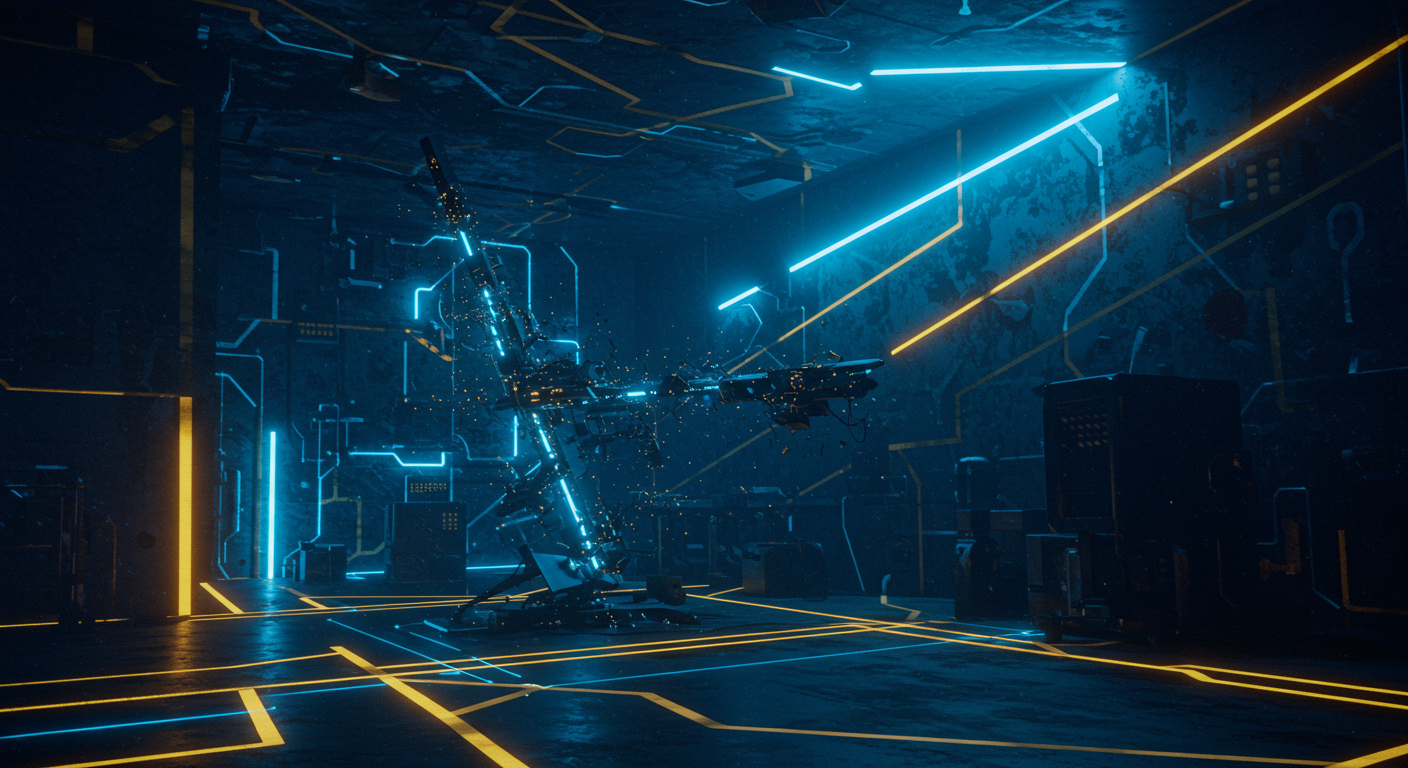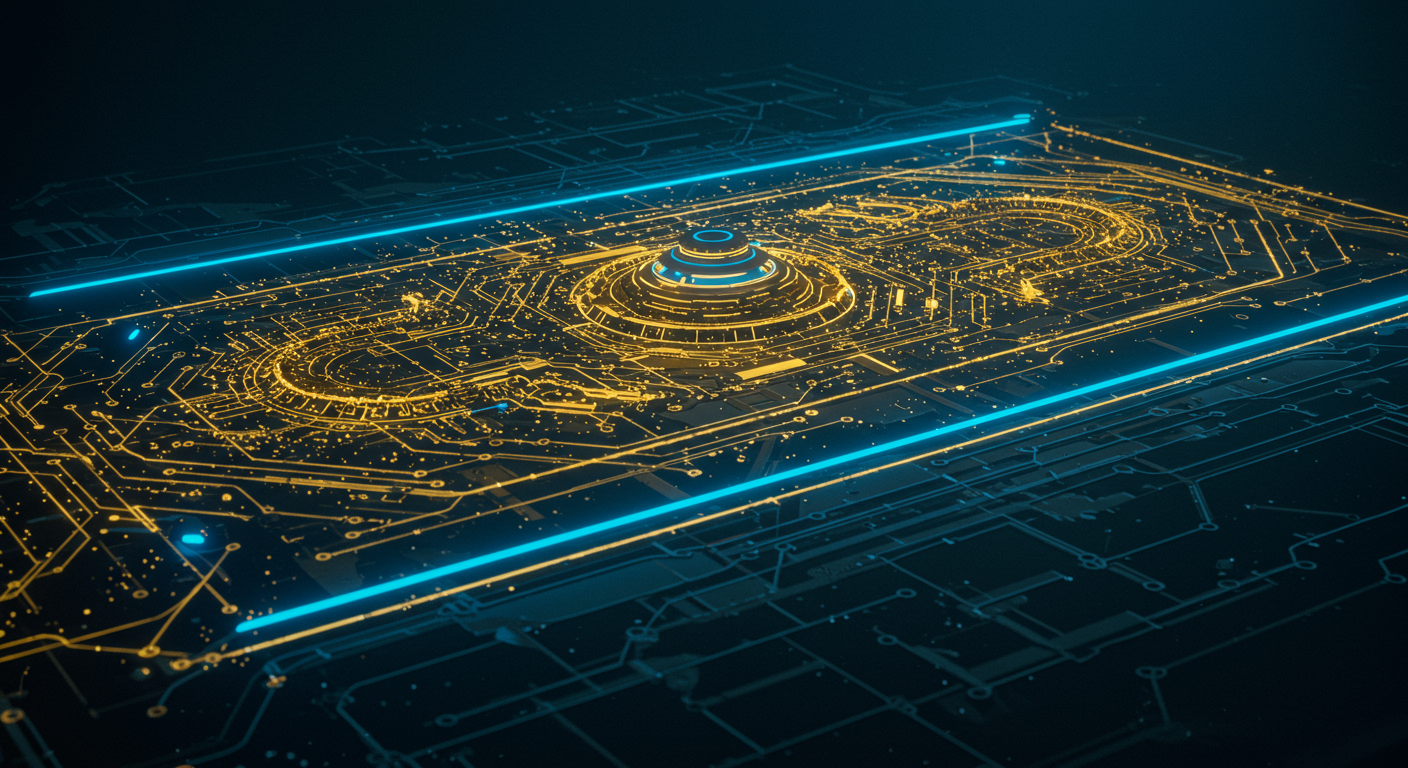Supervised Reinforcement Learning: How SRL is Revolutionizing Small Language Model Reasoning

Here's how Supervised Reinforcement Learning is teaching Small Language Models (SLMs) new tricks.
Introduction: The Quest for Reasoning in Small Language Models
Imbuing small language models (SLMs) with strong reasoning abilities is proving to be a complex challenge, especially when it comes to next-gen problem-solving. Traditional training methods often fall short, leaving SLMs struggling with tasks that require deeper analytical capabilities. Now, Supervised Reinforcement Learning (SRL) is emerging as a game-changing solution. SRL offers a pathway to guide SLMs towards more sophisticated reasoning.Why SRL Matters for SLMs
- Expert Guidance: SRL leverages expert trajectories, essentially providing SLMs with exemplary demonstrations of how to approach and solve problems. This is akin to having a seasoned mentor showing the SLM the ropes.
- Overcoming Limitations: Traditional training methods struggle with complex, multi-step tasks. SRL allows SLMs to learn from curated sequences of actions, thereby mastering intricate problem-solving processes.
- Edge Device Potential: SLMs are uniquely suited for edge devices and resource-constrained environments. SRL enhances their capabilities, unlocking exciting possibilities for on-device AI applications.
Expert Trajectories: The Secret Ingredient
Expert trajectories are crucial in SRL. They provide the SLM with a roadmap, showcasing optimal decision-making at each step.
This contrasts sharply with simply feeding the SLM vast datasets of text, which may not offer the specific guidance needed for reasoning-intensive tasks. Think of it as the difference between reading a cookbook and watching a master chef in action.
The Impact on Various Applications
The rise of SRL is poised to impact a wide array of applications, from enhancing the performance of Software Developer Tools to creating more intelligent and efficient Design AI Tools. Expect to see smarter edge devices, more capable AI assistants, and innovative solutions in resource-limited settings.In conclusion, Supervised Reinforcement Learning holds significant promise for overcoming the limitations of SLMs. By guiding these models with expert trajectories, we can unlock their full reasoning potential and pave the way for a new wave of intelligent applications. Stay tuned as we continue to explore the evolution of AI and its impact on our daily lives. You can find more tools and information on our AI Tool Directory.
Here's how Supervised Reinforcement Learning is changing the AI game, especially for Small Language Model (SLM) reasoning.
Understanding Supervised Reinforcement Learning (SRL): A Step-by-Step Breakdown
Supervised Reinforcement Learning (SRL) is a clever hybrid, blending the targeted precision of supervised learning with the dynamic decision-making of reinforcement learning. Think of it as teaching an AI not just what to do, but why it's the best move.
How SRL Combines Two Techniques
SRL isn't just bolting two methods together; it's about leveraging their strengths:
- Supervised Learning: Provides initial guidance, showing the SLM what "good" behavior looks like.
- Reinforcement Learning: Refines this behavior through trial and error, rewarding actions that lead to desired outcomes.
SRL Framework: Data, Rewards, Optimization
The magic happens in a few key stages:
- Data Collection (Expert Trajectories): Imagine learning chess by watching grandmasters. SRL starts with observing "expert trajectories"—high-quality examples of the task at hand. These act as a guiding light for the SLM.
- Reward Function Design: This is the AI equivalent of setting goals. A well-crafted reward function tells the SLM what constitutes success.
- Policy Optimization: The SLM fine-tunes its strategy (policy) to maximize these rewards, learning to make optimal decisions in various scenarios.
The Power of Expert Trajectories
Expert trajectories are crucial because they provide a strong foundation for the SLM. They offer clear, high-quality guidance, making the learning process more efficient. This is why they are used for Small Language Model reasoning, due to the limited resources.
SRL vs. Traditional RL: Efficiency and Stability
Compared to traditional RL, SRL offers some impressive advantages:
- Data Efficiency: SRL needs less data because it starts with expert knowledge, reducing the need for extensive exploration.
- Stability: The supervised component provides stability, preventing the SLM from going off the rails during training.
Revolutionizing small language model (SLM) reasoning involves leveraging the power of expert guidance.
The Essence of Expert Trajectories
Expert trajectories are essentially demonstrations of optimal behavior for an SLM to mimic. They're generated by:
- Human experts: Manually crafting solutions.
- Rule-based systems: Using pre-defined rules to arrive at a solution.
- Pre-trained models: Employing larger, more capable models to generate the trajectories.
Methods of Creation
Creating expert trajectories can involve several approaches:
- Manual annotation: Labor-intensive but ensures high quality and relevance.
- Automated generation: Faster but requires careful validation to avoid propagating biases or errors.
- Hybrid approaches: Combining manual annotation with automated refinement. For instance, using a pre-trained model to generate initial trajectories, then having human experts refine them.
Quality Matters
High-quality expert trajectories are crucial. If the trajectories are flawed or incomplete, the SLM will learn suboptimal strategies, hindering its reasoning abilities. Bias can also sneak in, skewing results, and hindering fairness.
Challenges and Considerations
Gathering and curating expert trajectories is not without hurdles:
- Cost: Expert time and resources can be expensive.
- Bias: Human experts may exhibit biases that are inadvertently incorporated.
- Scalability: Generating trajectories for complex tasks can be computationally intensive.
- Generalization: It can be difficult to ensure that the trajectories cover a wide range of scenarios, limiting the SLM’s ability to generalize.
Real-World Examples
Expert trajectories can guide SLMs in various reasoning tasks:
- Logical deduction: Providing sequences of logical steps to arrive at a conclusion.
- Planning: Demonstrating how to break down a complex goal into smaller, manageable actions. For example, guiding a Software Developer Tools AI to write efficient, well-documented code.
Supervised Reinforcement Learning (SRL) is proving transformative, especially for reasoning tasks in Small Language Models (SLMs).
SRL in Action: Real-World Applications and Use Cases

SRL offers a compelling pathway for SLMs to tackle complex tasks with limited computational resources. Here's where it shines:
- Robotics: SRL enables robots to learn intricate manipulation skills from demonstrations. Imagine a robot learning to assemble furniture by observing a human expert, refining its movements through trial and error using reinforcement learning principles.
- Autonomous Navigation: SLMs powered by SRL can navigate dynamic environments, making real-time decisions. Think self-driving drones navigating a warehouse, optimizing their routes while avoiding obstacles.
- Game Playing: SRL equips SLMs with strategic decision-making abilities in games. For example, an SLM can learn to play chess, refining its moves using reinforcement learning to maximize its chances of winning.
- Natural Language Processing:
- Question Answering: SRL improves SLMs' ability to understand context and provide accurate answers. SRL can refine the answering process, leading to more insightful responses.
- Text Summarization: SRL enhances SLMs' capacity to generate concise and coherent summaries. For example, an SLM can learn to summarize legal documents, identifying key information and presenting it in a clear and understandable manner.
- Logical Inference & Decision-Making: SRL allows SLMs to perform complex tasks requiring logical steps.
Benefits in Resource-Constrained Environments
SRL is especially beneficial in edge devices and resource-limited settings, enabling more sophisticated AI functionality on smaller devices.
In short, SRL allows researchers to train Machine Learning models using Scientific Research techniques.
SRL is enabling remarkable advances in SLM reasoning, opening doors to innovative applications across diverse fields and empowering AI in resource-constrained environments. Now, let's delve into the tools that make this possible.
Supervised Reinforcement Learning (SRL) is emerging as a clever shortcut, teaching AI reasoning without years of traditional trial and error.
What's the Difference?

Traditional reinforcement learning (RL) operates on a "learn by doing" principle, where an agent explores an environment and learns through trial and error, receiving rewards or penalties for its actions. Think of it like training a dog: you reward good behavior and correct bad behavior. But this can be incredibly inefficient. SRL, on the other hand, uses "expert" demonstrations to guide learning.
It's like giving the dog a cheat sheet showing all the best tricks already.
Here's a quick breakdown:
| Feature | Traditional RL | Supervised RL (SRL) |
|---|---|---|
| Learning Method | Trial and error | Learning from expert trajectories |
| Data Efficiency | Low | High |
| Stability | Can be unstable | More stable |
| Implementation | Complex | Simpler |
| Reliance on Experts | No | Yes |
SRL's Upsides: Efficiency and Stability
- Data efficiency: SRL requires significantly less data compared to traditional RL, making it practical for problems where data collection is expensive or time-consuming. Imagine teaching a robot to perform surgery; you wouldn't want it learning solely through trial and error!
- Stability: SRL tends to be more stable because it learns from proven strategies, reducing the risk of the agent converging on suboptimal or erratic behavior.
- Ease of Implementation: SRL algorithms are often easier to implement than complex RL algorithms, accelerating development and deployment.
The Catch: Dependence and Potential Bias
- Reliance on Expert Trajectories: SRL's performance hinges on the quality and availability of expert data. If the expert is flawed, so too will be the learning.
- Potential for Bias: If the expert data reflects biases, the SRL agent will likely inherit those biases, leading to unfair or skewed outcomes. Think about it: if you only train an AI on data from one demographic, it's unlikely to perform well for others.
Choosing the Right Path
When should you pick Supervised Reinforcement Learning over traditional RL?
- SRL: Ideal when you have access to good demonstration data and need a stable, efficient solution.
- Traditional RL: Better suited when you need to discover novel strategies and are willing to invest the time and resources for extensive exploration.
Supervised Reinforcement Learning (SRL) unlocks unprecedented reasoning capabilities in Small Language Models (SLMs).
Tools and Frameworks
Several tools and frameworks can aid in SRL implementation:- TensorFlow: A versatile open-source library for numerical computation and large-scale machine learning. TensorFlow offers flexibility and comprehensive tools for defining and training complex models. For more information, visit the TensorFlow website.
- PyTorch: Another popular open-source machine learning framework known for its dynamic computation graph and ease of use. PyTorch's flexibility and strong community support make it ideal for research and development. To explore, check the PyTorch home.
- Specialized SRL Libraries: Libraries focusing specifically on reinforcement learning, like OpenAI Gym or Dopamine, can streamline SRL implementation.
Designing Reward Functions and Expert Trajectories
Careful design here makes all the difference:- Reward functions should align with desired reasoning behavior. For instance, rewarding accurate answers and penalizing incorrect ones can guide the SLM towards better reasoning.
- Expert trajectories offer ideal sequences of actions, providing valuable guidance during training. Consider high-quality datasets.
Training SLMs with SRL: Best Practices
Effective training necessitates a structured approach:- Hyperparameter Tuning: Experiment with learning rates, batch sizes, and reward scaling to optimize performance.
- Evaluation Metrics: Utilize metrics like accuracy, BLEU score, and task-specific measures to assess reasoning capabilities. Check out the AI Glossary to demystify these terms.
Addressing Common Challenges
Expect a few bumps along the road:- Reward Shaping: Crafting a reward function that’s neither too sparse nor too dense can be challenging.
- Exploration vs. Exploitation: Balancing exploration of new actions with exploitation of known successful strategies is critical.
Supervised Reinforcement Learning (SRL) is poised to redefine how Small Language Models (SLMs) approach complex reasoning tasks.
Emerging Trends and Future Directions
The field of SRL is rapidly evolving, with key trends pointing toward more efficient and adaptable SLMs:- Advancements in Expert Trajectory Generation: Current research focuses on creating more diverse and informative expert trajectories, moving beyond simple demonstrations. Imagine AI tutors learning from seasoned educators, not just textbooks.
- Refined Reward Function Design: Designing reward functions that accurately reflect desired behavior is crucial. New techniques aim to balance simplicity with effectiveness, guiding SLMs toward optimal reasoning strategies.
- Scalability Improvements: The focus is on making SRL more practical for real-world applications. Scalability enhancements address the computational demands of training, enabling SRL to be applied to larger and more complex datasets.
Challenges and Opportunities
Despite its promise, SRL faces hurdles:- Robustness and Generalization: Ensuring SLMs trained with SRL can handle unseen scenarios remains a challenge. Researchers are exploring techniques to improve the robustness and generalization capabilities of these models.
- Scalability: Can SRL keep pace with growing data and model complexity?
- Innovation and Collaboration: The SRL field offers vast opportunities for innovation in algorithms, architectures, and applications. Increased collaboration between academia and industry is crucial for unlocking SRL's full potential.
The Future Impact on SLMs
SRL has the potential to significantly enhance the capabilities of SLMs:- Enhanced Reasoning: SLMs will demonstrate more sophisticated problem-solving abilities. Think of AI assistants capable of handling intricate customer inquiries with nuanced, logical responses.
- Improved Decision-Making: SRL could enable SLMs to make better decisions in dynamic environments. For example, optimizing supply chains or personalizing healthcare recommendations.
Supervised Reinforcement Learning (SRL) is proving to be a game-changer, turbocharging reasoning capabilities in even the smallest language models.
The Power of SRL: A Recap
SRL cleverly combines the best of both worlds: the precision of supervised learning with the exploratory power of reinforcement learning. Expert trajectories are the compass, guiding small language models (SLMs) toward optimal solutions.
- Enhanced Reasoning: SRL pushes SLMs beyond simple pattern recognition, enabling them to tackle complex reasoning tasks. Think of it as giving your pocket calculator the ability to solve differential equations.
- Unlocking New Potential: SRL has the potential to unlock a wave of new applications for SLMs.
A Call to Action
Now is the time to dive in, experiment, and push the boundaries of what's possible. Tools like ChatGPT and guides like Best AI Writing Tools 2025: Find the Perfect AI Writing Assistant Chatgpt Grammarly can help you get started.
In conclusion, SRL stands as a pivotal innovation, poised to redefine the landscape of intelligent systems and usher in a new era of AI capabilities.
Keywords
Supervised Reinforcement Learning, SRL, Small Language Models, Reasoning in AI, Expert Trajectories, AI Training Methods, Machine Learning, Reinforcement Learning, SLM Reasoning, AI Algorithms, Reward Function Design, Policy Optimization, AI applications, Training data
Hashtags
#SupervisedReinforcementLearning #SmallLanguageModels #AIReasoning #ExpertTrajectories #MachineLearning
Recommended AI tools
ChatGPT
Conversational AI
AI research, productivity, and conversation—smarter thinking, deeper insights.
Sora
Video Generation
Create stunning, realistic videos and audio from text, images, or video—remix and collaborate with Sora, OpenAI’s advanced generative video app.
Google Gemini
Conversational AI
Your everyday Google AI assistant for creativity, research, and productivity
Perplexity
Search & Discovery
Clear answers from reliable sources, powered by AI.
DeepSeek
Conversational AI
Efficient open-weight AI models for advanced reasoning and research
Freepik AI Image Generator
Image Generation
Generate on-brand AI images from text, sketches, or photos—fast, realistic, and ready for commercial use.
About the Author

Written by
Dr. William Bobos
Dr. William Bobos (known as 'Dr. Bob') is a long-time AI expert focused on practical evaluations of AI tools and frameworks. He frequently tests new releases, reads academic papers, and tracks industry news to translate breakthroughs into real-world use. At Best AI Tools, he curates clear, actionable insights for builders, researchers, and decision-makers.
More from Dr.

